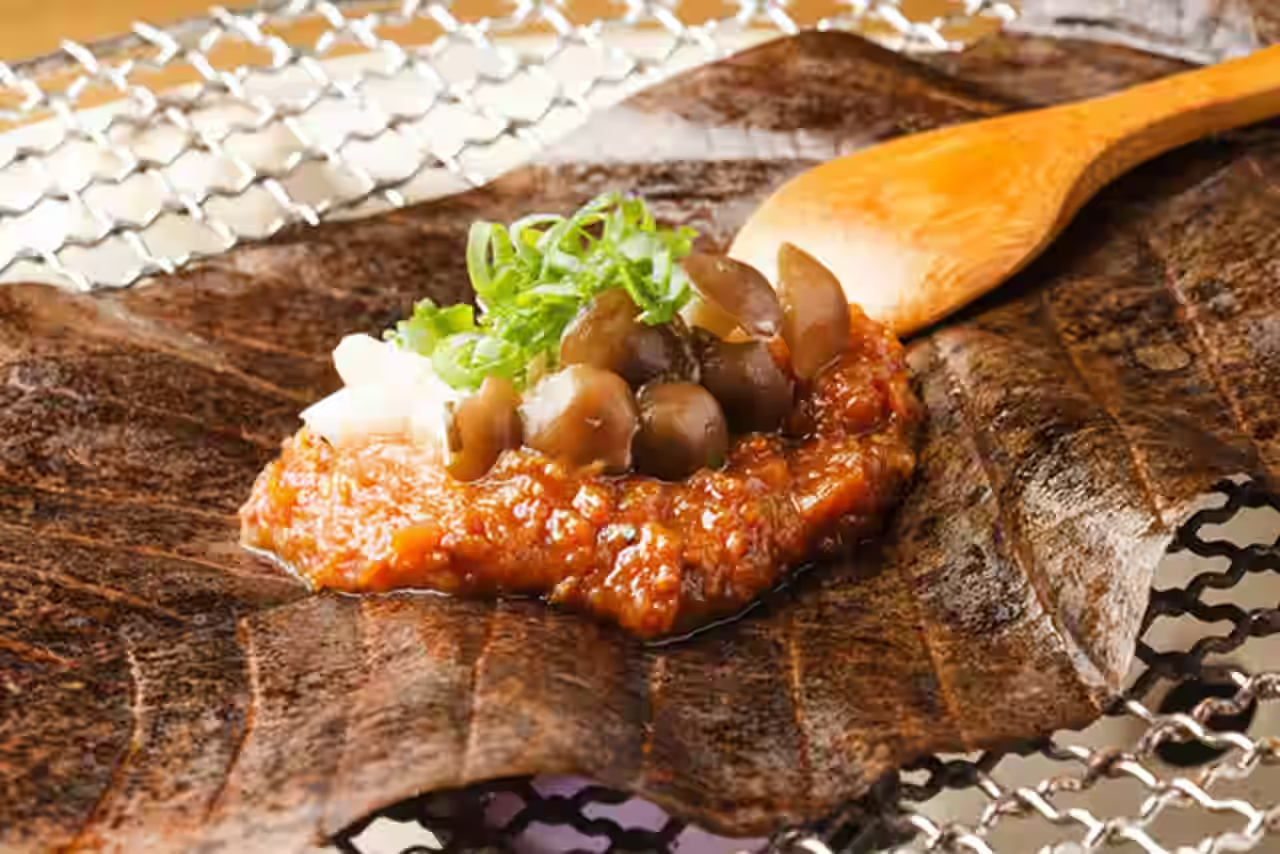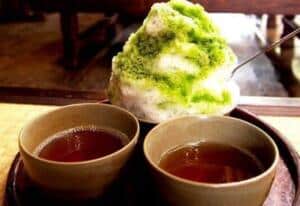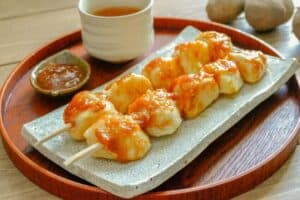INTRODUCTION TO YOUKAN

Now we have one of the oldest Japanese wagashi. Yokan (羊羹) is one of the most common traditional Japanese sweets whose origin is back about 700 years ago. It is a simple jelly-like dessert that has ingredient of Azuki red bean paste (anko). They usually cook it with water, sweetened with sugar, and it is solidified with agar or also known as Kanten. Originating from China, then Youkan evolved into a type of traditional Japanese confectionery with many different variations now available. Let’s learn more about this interesting wagashi!
ETYMOLOGY

Youkan is 羊羹 in Chinese/Japanese Kanji which contains both the Chinese character for “sheep” (羊) and “broth” (羹). The word itself contains a number of clues as to the origins of this jelly dessert. Originally, they use that term for sheep meat soup in China. It was therefore called ‘sheep soup’
WHAT IS THE HISTORY OF YOUKAN?

Youkan was first introduced to Japan from China in around 1191. It was first introduced to Japan from China at that time. Originally, it was a Chinese jelly coming from boiling sheep gelatin while making mutton soup. Once cooled, the gelatin in the soup solidified into a texture similar to jelly. However, the monks who imported the dish into Japan were Buddhists were vegetarians. It was brought to Japan sometime during the Kamakura-Muromachi period (between 1185-1573) by a monk who studied abroad in China. That was when they invent the vegetarian version of yokan using red beans. As such, a new version of yokan was developed using azuki beans or also called sweet red beans. This is the yokan we’re familiar with today.
In the Edo period during year 1589, Okamoto Zenemon, the fifth generation of Tsuruya in Fushimi Kugo, Yamashiro Province, developed a new type of nen-yokan (sweet bean jelly) made of tengusa (a raw material for agar), raw sugar, and red bean paste. He then presented to Toyotomi Hideyoshi. Tsuruya moved to Wakayama, Kii Province, following Yorinobu Tokugawa, and changed its name to Suruga-ya, but it continued to make improvements. In 1658, it came to be marketed as a finished product.
WHAT ARE THE OTHER TYPES OF YOUKAN?

There are three types of youkan and these are: Neri Youkan which means paste, Mizu means water, and Mushi that means steamed Youkan. Neri yokan is the most common variety of Youkan. It is made using quite a little Kanten agar so it’s a pasty red bean cake.
Mizu yokan, on the other hand, uses less agar and more water, producing a lighter, smoother jelly. The difference in texture between Neri Youkan and Mizu Youkan is similar to the relation between firm tofu and soft tofu. It is literally more watery than Neri Youkan. This is because this type contains a lower proportion of Kanten agar than Neri Yokan. Japanese tend to often eat Mizu Youkan during hot summer months since the jelly dessert has a cool appearance and refreshing taste. Finally, Mushi youkan is a Youkan without using Kanten agar. This type is made from Azuki red bean paste that has been mixed with wheat or kudzu (arrowroot) flour and steamed.
WHAT ARE THE HEALTH BENEFITS AND CALORIES OF YOUKAN?

Youkan has good effects like low calorie, intestinal regulation, skin-beautifying effects. Japanese sweets are indeed good. If you have sweet tooth but are on diet, we would definitely recommend a Japanese sweet since it has low calories because it does not use fat such as butter, cream, and eggs. Additionally, Japanese sweets using agar and red beans are rich in dietary fiber.
The calorie of each piece of Mizu Youkan per 100g is around 74kcal and for normal Youkan it’s around 216kcal. The raw materials for water yokan and yokan are almost the same. But while most yokan is coming from red bean paste, more than half of the mass of water yokan is water. Since the bean paste already contains sugar, yokan with a large amount of bean paste has a high sugar mass and calories.
Additionally, Youkan is said to be the best standard energy supplement according to most cyclists who ride bicycles such as road bikes and cross bikes. Youkan is surprisingly chosen as one of those energy supplement foods along with Snickers and Calorie mate that are famous energy bars. Moreover, Youkan has more advantages since it does not melt easily unlike chocolates, so it can be carried more conveniently. Also, it can be bought in every convenience store.
As per health effects, it can help constipation and swelling improvements, and also anemia prevention since it has iron. It is also effective for dieting since it includes vitamin B1 which converts sugar into energy. Red bean has an anti-aging effect as well so it can be good for beauty and concentration improvement by adding sugar and making red bean paste.
WHAT ARE THE INGREDIENTS OF YOUKAN?

Youkan is super easy to make at home! Main recipes usually are these ingredients: red bean paste, water, salt, sugar and kanten agar powder. In case you’re wondering what is Agar powder, it is also known as agar-agar and is similar to gelatin powder where you can see in various grocery stores everywhere.
For the materials, you will be needing a saucepan, whisk, wooden spatula, and nagashikan (it’s like a mold for eggs and tofu)
HOW TO MAKE YOUKAN?

Firstly, dissolve and boil the kanten agar powder with water in a small saucepan, whisking and simmering until the powder has completely dissolved. If you do not boil the agar for 1 to 2 minutes, the coagulation rate will decrease and it will become difficult to solidify, so be sure to heat it in a boiled state for 1 to 2 minutes.
Put water, powdered agar, and white sugar in a pan and boil over medium heat for at least 1 minute. Then, add red bean paste and heat over low heat while mixing without burning.
After mixing all with a wooden spatula, the bottom can be seen, and when it is boiled to the extent that the sauce does not return immediately, pour it into a mold or nagashikan, cool it in the refrigerator for 1 hour or more after removing the rough heat, harden it, and remove it from the mold.
After 2 hours, remove your jelly from the container, slice it into cubes, and enjoy! You can also add toppings like brown sugar. It’s gonna be perfect for tea time!
WHAT ARE THE RECOMMENDED SHOPS OF YOUKAN?

Gokkateya Honpo Main Store
This store started manufacturing and selling yokan in 1897 using beans from Hokkaido and agar sugar carried by Kitamaebune. You can push the yokan from the bottom as much as you want to eat and cut it to your favorite size with the special thread attached to the container.
Tamashimaya Main Store
Tamashimaya store is a long-established store that has been around since the Edo period. It was born in 1945 by devising a method to put it in rubber so that it is easy to eat even in the battlefield. If you stab it with a toothpick, the rubber will peel off and the contents will come out smoothly.
Mitsuyama Youkan Honpo
They have traditional youkan with natural flavor and heavy sweetness condensed into bite-sized pieces. It was founded in 1887 on the road from Nikko Station to Toshogu. Their Youkan has a bite-sized sweetness. The deep color and sweetness that brings out the natural flavor is a traditional taste of good old Japan.
Toraya Akasaka Store
Toraya is a long-established Japanese confectionery founded in Kyoto in the latter half of the Muromachi period. Recommended products are Ogura Youkan “Yoru no Ume”, “Omokage” using brown sugar from Okinawa and Nishi-Omotesando, “Fresh green” with matcha scent, and elegant white bean paste with rich honey flavor.
FINAL WORDS

In conclusion, traditional Japanese desserts or wagashi are usually enjoyed with a cup of green tea served during tea ceremonies. Additionally, the ingredients of wagashi are has a plant ingredients like azuki beans, rice cakes, rice flour, agar, sesame paste, and more. Moreover, vegetarians and those who are on a strict diet would be able to enjoy most wagashi without having to worry about the calorie diet.
In addition, Youkan is completely customizable with variations and also with alternate sweeteners like honey and brown sugar. Nowadays, not only can you enjoy it as a Japanese sweet, but you can also buy yokan as a nutritional supplement for emergency food and sports. Yokan is also available in every convenience store and became a favorite souvenir by tourists.
FAQ
What is Yokan?
Yokan is a traditional Japanese sweet made primarily from red bean paste, sugar, and agar. It has a firm, jelly-like texture and is commonly enjoyed with tea.
What does Yokan taste like?
Yokan has a rich, mildly sweet flavor with the natural earthiness of beans. The taste varies depending on ingredients such as red beans, white beans, or chestnuts.
Are there different types of Yokan?
Yes. The two main types are neri-yokan (firm and dense) and mizu-yokan (softer and higher in water content, often eaten chilled in summer).
How is Yokan typically eaten?
Yokan is usually sliced into small pieces and paired with green tea. Its sweetness complements the bitterness of matcha or sencha.
Does Yokan need refrigeration?
Unopened packaged Yokan usually does not require refrigeration. Once opened, it is best stored in the refrigerator and consumed quickly for freshness.
Is Yokan suitable for vegans?
Most Yokan is vegan-friendly because it uses agar (a seaweed-derived gelatin substitute) instead of animal gelatin. However, ingredients may vary, so checking labels is recommended.
How long does Yokan last?
Packaged Yokan often has a long shelf life due to its high sugar content. Some varieties can last for months if unopened and stored properly.
What are popular flavor variations of Yokan?
Common variations include chestnut, green tea, white bean, black sugar, and sweet potato. Regional specialties also exist throughout Japan.
Where can I buy Yokan?
Yokan can be purchased at Japanese confectionery shops, supermarkets, souvenir stores, and online retailers. Famous brands are often sold as gifts.
Is Yokan considered a traditional gift?
Yes. Yokan is a classic Japanese gift item due to its elegant presentation, long shelf life, and cultural significance as a traditional confection.
















Comments